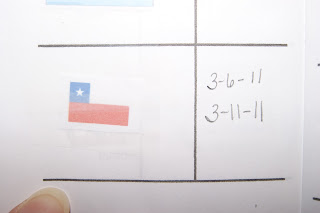Our adjusted Chile notebook pages. I list facts and pictures of the country and where it is located.
Printed flag from Enchanted Learning.
Things we learned about Chile:
- Capital: Santiago
- Population: 17,094,270
- Language: Spanish
- Total Square Miles: 292,183 sq mi
- If you live in Chile, you would be known as a Chilean.
- Currency: PESO
- Government Unitary presidential republic
- Climate: Chile within its borders hosts at least seven major climatic subtypes, ranging from desert in the north, to alpine tundra and glaciers in the east and south east, humid subtropical in Easter Island, Oceanic in the south and Mediterranean climate in central Chile. There are four seasons in most of the country: summer (December to February), autumn (March to May), winter (June to August), and spring (September to November).
- Chile is divided into 15 regions, each headed by an intendant appointed by the president. The regions are further divided into provinces, with provincial governors also appointed by the president. Finally each province is divided into communes[64] which are administered by municipalities, each with its own mayor and council elected for four year terms. Each region is designated by a name and a Roman numeral, assigned from north to south. The only exception is the Santiago Metropolitan Region which is designated RM (Región Metropolitana). Two new regions were created in 2006 and became operative in October 2007; Los Ríos in the south (Region XIV), and Arica y Parinacota in the north (Region XV). The numbering scheme skipped Region XIII.
Animals of Chile
Pink Chilean Flamingo ---- It can be differentiated from these species by its greyish legs with pink "knees", and also by the larger amount of black on the bill (more than half). Young chicks may have no sign of pink coloring whatsoever, but instead remain grey.

Alpacas ---- Alpaca fiber is used for making knitted and woven items, much as wool is. These items include blankets, sweaters, hats, gloves, scarves, a wide variety of textiles and ponchos in South America, and sweaters, socks, coats and bedding in other parts of the world.

Llaca ---- This mammal has dense and silky fur, of a light brown in its tummy area and grey on its back. It has a long tail, sharp snout and sharp teeth, and it looks like a small rat. It has big ears and you can recognize it because they have a dark spot around their eyes.

Pudu ---- The world’s smallest deer. They are 13-17 inches tall and 33 inches long. The Pudu is a timid animal, of nocturnal habits, it feeds on herbs. Females give birth to a single young, which is of a reddish color with white stripes down its thighs and the back. The stripes disappear after three months.

Coati ----Carnivorous mammal that also feeds on eggs and fruits. It has a long snout and a well developed sense of smell. It is highly sociable, especially in its youth. The adult male drifts off from the rest of the animals and goes back to the group in mating season.

Viscacha ---- They live in colonies of 10 to over 100 just like meerkats

Viscacha ---- They live in colonies of 10 to over 100 just like meerkats
We made the National Dish of Chile......Cazuela.
Even Brayden went and got a bowl. It was basically a big chicken soup, but the chicken is left on the bone. Not my favorite way of eating chicken soup, but it was still really yummy!!!!
A souvenier from Great-grandma Lydia. Brayden will be talking about Huasos (wasos).
We quickly made a costume for his presentation.
Lydia and Joey had more hands on projects. Joey wanted to talk about Easter Island. So he made monolithic statues like the ones found on the island.
Lydia is making a model of an earth oven from mud we dug up under the snow in the backyard.
The book end brought back from Chile featuring an earth oven and Lydia's model she created:
Joey's finished statues.
Next week we will be returning to Europe and studying Greece.












No comments:
Post a Comment